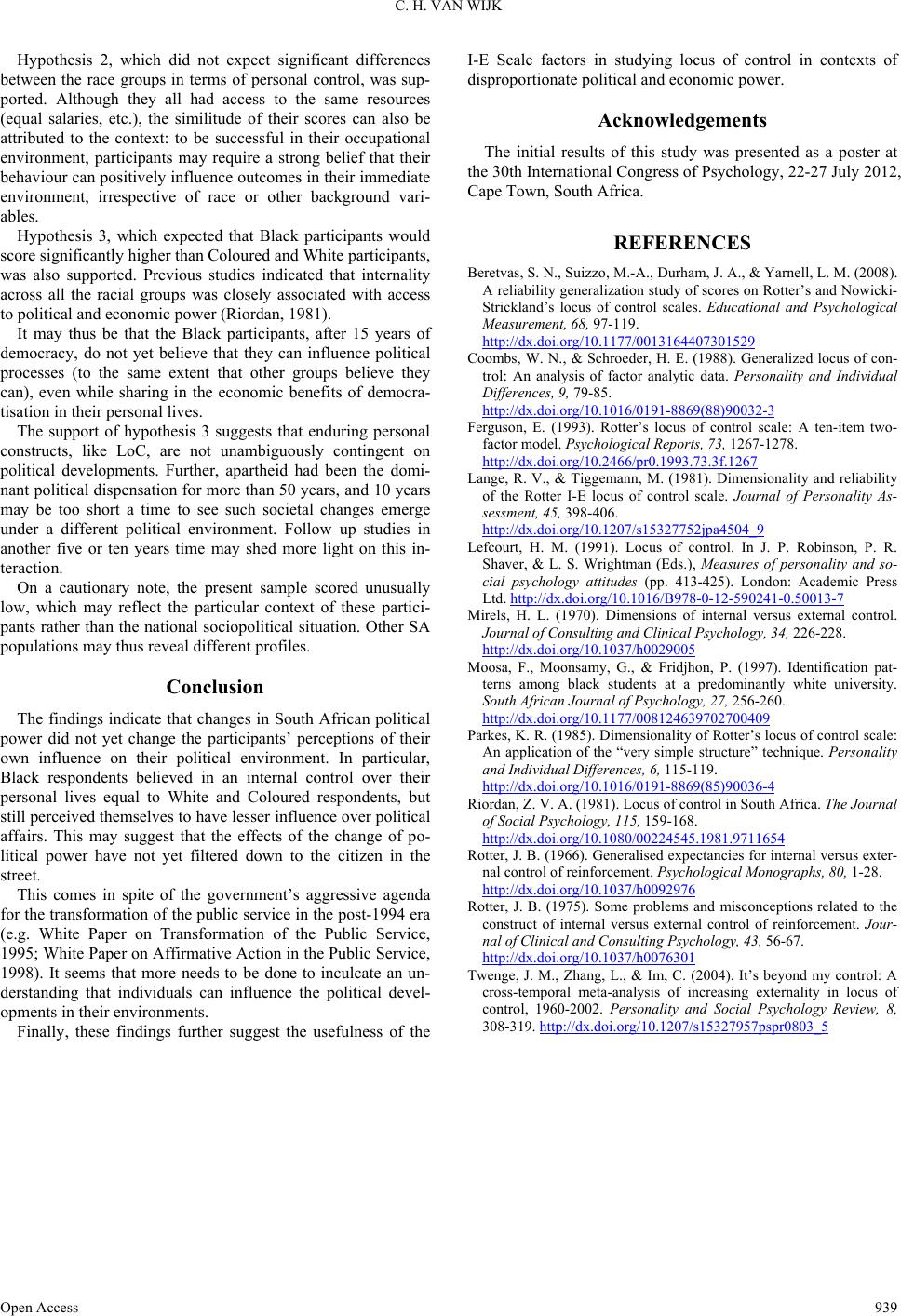
C. H. VAN WIJK
Open Access 939
Hypothesis 2, which did not expect significant differences
between the race groups in terms of personal control, was sup-
ported. Although they all had access to the same resources
(equal salaries, etc.), the similitude of their scores can also be
attributed to the context: to be successful in their occupational
environment, participants may require a strong belief that their
behaviour can positively influence outcomes in their immediate
environment, irrespective of race or other background vari-
ables.
Hypothesis 3, which expected that Black participants would
score significantly higher than Coloured and White participants,
was also supported. Previous studies indicated that internality
across all the racial groups was closely associated with access
to political and economic power (Riordan, 1981).
It may thus be that the Black participants, after 15 years of
democracy, do not yet believe that they can influence political
processes (to the same extent that other groups believe they
can), even while sharing in the economic benefits of democra-
tisation in their personal lives.
The support of hypothesis 3 suggests that enduring personal
constructs, like LoC, are not unambiguously contingent on
political developments. Further, apartheid had been the domi-
nant political dispensation for more than 50 years, and 10 years
may be too short a time to see such societal changes emerge
under a different political environment. Follow up studies in
another five or ten years time may shed more light on this in-
teraction.
On a cautionary note, the present sample scored unusually
low, which may reflect the particular context of these partici-
pants rather than the national sociopolitical situation. Other SA
populations may thus reveal different profiles.
Conclusion
The findings indicate that changes in South African political
power did not yet change the participants’ perceptions of their
own influence on their political environment. In particular,
Black respondents believed in an internal control over their
personal lives equal to White and Coloured respondents, but
still perceived themselves to have lesser influence over political
affairs. This may suggest that the effects of the change of po-
litical power have not yet filtered down to the citizen in the
street.
This comes in spite of the government’s aggressive agenda
for the transformation of the public service in the post-1994 era
(e.g. White Paper on Transformation of the Public Service,
1995; White Paper on Affirmative Action in the Public Service,
1998). It seems that more needs to be done to inculcate an un-
derstanding that individuals can influence the political devel-
opments in their environme n t s .
Finally, these findings further suggest the usefulness of the
I-E Scale factors in studying locus of control in contexts of
disproportionate political and economic power.
Acknowledgements
The initial results of this study was presented as a poster at
the 30th International Congress of Psychology, 22-27 July 2012,
Cape Town, South Africa.
REFERENCES
Beretvas, S. N., Suizzo, M.-A., Durham, J. A., & Yarnell, L. M. (2008).
A reliability generalization study of scores on Rotter’s and Nowicki-
Strickland’s locus of control scales. Educational and Psychological
Measurement, 68, 97-119.
http://dx.doi.org/10.1177/0013164407301529
Coombs, W. N., & Schroeder, H. E. (1988). Generalized locus of con-
trol: An analysis of factor analytic data. Personality and Individual
Differences, 9, 79- 85.
http://dx.doi.org/10.1016/0191-8869(88)90032-3
Ferguson, E. (1993). Rotter’s locus of control scale: A ten-item two-
factor model. Psychological Reports, 73, 1267-1278.
http://dx.doi.org/10.2466/pr0.1993.73.3f.1267
Lange, R. V., & Tiggemann, M. (1981). Dimensionality and reliability
of the Rotter I-E locus of control scale. Journal of Personality As-
sessment, 45, 398-406.
http://dx.doi.org/10.1207/s15327752jpa4504_9
Lefcourt, H. M. (1991). Locus of control. In J. P. Robinson, P. R.
Shaver, & L. S. Wrightman (Eds.), Measures of personality and so-
cial psychology attitudes (pp. 413-425). London: Academic Press
Ltd. http://dx.doi.org/10.1016/B978-0-12-590241-0.50013-7
Mirels, H. L. (1970). Dimensions of internal versus external control.
Journal of Consulting and Cli n ic al Psychology, 34, 226-228.
http://dx.doi.org/10.1037/h0029005
Moosa, F., Moonsamy, G., & Fridjhon, P. (1997). Identification pat-
terns among black students at a predominantly white university.
South African Journal of Psychology, 27, 256-260.
http://dx.doi.org/10.1177/008124639702700409
Parkes, K. R. (1985). Dimensionality of Rotter’s locus of control scale:
An application of the “very simple structure” technique. Personality
and Individual Diff erences, 6, 115-119.
http://dx.doi.org/10.1016/0191-8869(85)90036-4
Riordan, Z. V. A. (1981). Locus of contr ol in South Africa. The Journal
of Social Psychology, 115, 159-168.
http://dx.doi.org/10.1080/00224545.1981.9711654
Rotter, J. B. (1966). Generalised expectancies for internal versus exter-
nal control of reinforcement. Psychological Monographs, 80, 1-28.
http://dx.doi.org/10.1037/h0092976
Rotter, J. B. (1975). Some problems and misconceptions related to the
construct of internal versus external control of reinforcement. Jour-
nal of Clinical and Consulting Psychology, 43, 56-67.
http://dx.doi.org/10.1037/h0076301
Twenge, J. M., Zhang, L., & Im, C. (2004). It’s beyond my control: A
cross-temporal meta-analysis of increasing externality in locus of
control, 1960-2002. Personality and Social Psychology Review, 8,
308-319. http://dx.doi.org/10.1207/s15327957pspr0803_5